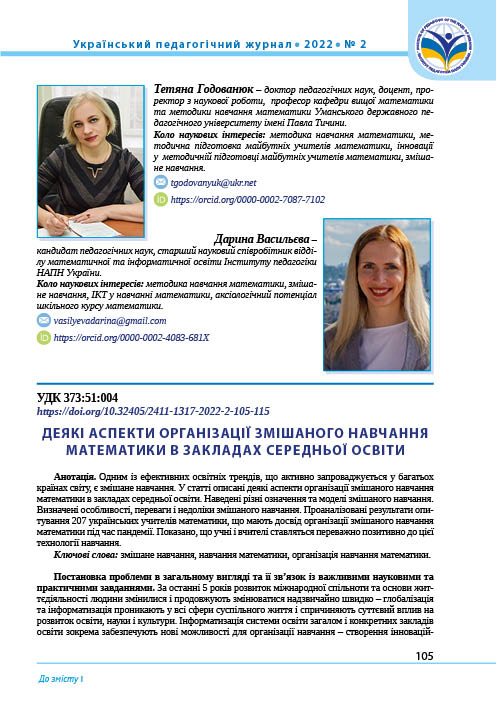Abstract
Blended learning is one of the effective educational trends that is being actively implemented in many countries around the world. Blended learning became most popular during the pandemic, as it made it possible to ensure the safe learning of students during ongoing quarantines. Some aspects of the organization of mathematics blended education in school are described in the article. Different definitions and models of blended learning are given. Features, advantages and disadvantages of blended learning are identified. Blended learning changes the interaction between students and teacher, involves the active role of the student and makes it possible to take into account his educational needs. At the same time, blended learning requires technical support for all participants in the learning process and a fairly high level of flexibility for everyone.
It is shown that for 2 years of active implementation of mathematics blended learning, teachers and students have developed a mostly positive attitude to this learning technology and experience of using different models of blended learning. Teachers have seen a tendency to reduce student responsibility, although they note that the introduction of blended learning has developed a variety of key student competencies, especially student independence and lifelong learning.
Most often, mathematics teachers offer algorithmic, practical and research problems for students to study on their own. Sometimes teachers ask students to master new theoretical material in the form of videos or diagrams, examples of solved problems and tasks for self-fulfillment.
References
Collis, B. and Moonen, J. (2001). Flexible learning in a digital world: experiences and expectations. London, Great Britain: Kogan Page Limited. https://doi.org/10.4324/9780203046098
Bonk, C. and Graham, C. (2006). Handbook of blended learning: Global Perspectives, local designs. San Francisco, USA: Pfeiffer Publishing. http://curtbonk.com/toc_section_intros2.pdf
Christensen, C., Horn M. and Staker H. (2013). Is K‑12 Blended Learning Disruptive? An introduction of the theory of hybrids. San Francisco, USA: Clayton Christensen Institute. https://www.christenseninstitute.org/publications/hybrids/
Стрюк, А. (2011). Теоретичні основи комбінованого навчання. Збірник наукових праць Кам’янець-Подільського національного університету. Серія педагогічна. 17, С. 63–66. http://ped-series.kpnu.edu.ua/article/view/32063
Триус, Ю. та Герасименко, І. (2012). Комбіноване навчання як інноваційна освітня технологія у вищій школі. Теорія та методика електронного навчання: збірник наукових праць, вип. III, С. 299–308. https://www.ccjournals.eu/ojs/index.php/e-learn/article/view/353
Кривонос, О. (2013). Використання інформаційно-комунікаційних технологій в навчанні: навч. посібник. Житомир, Україна: Вид-во ЖДУ ім. І. Франка. http://eprints.zu.edu.ua/10166/
Бугайчук, К. (2016). Змішане навчання: теоретичний аналіз та стратегія впровадження в освітній процес вищих навчальних закладів. Інформаційно технологічні засоби навчання, вип. 54, № 4, С. 1–18. https://journal.iitta.gov.ua/index.php/itlt/article/view/1434/1070
Мар’єнко, М., Сухіх, А. (2021). Особливості організації змішаного навчання з використанням цифрових технологій. Освітній дискурс: збірник наукових праць. 32(4), С. 45–52.
Дистанційне навчання в умовах карантину: досвід та перспективи. Аналітико-методичні матеріали (2021). Київ, Україна: Педагогічна думка. https://undip.org.ua/library/dystantsiyne-navchannia-v-umovakh-karantynu-dosvid-ta-perspektyvy/
Коваленко, В., Мар’єнко, М. та Сухіх, А. (2021). Особливості впровадження змішаного навчання у закладах загальної середньої освіти. Нова педагогічна думка. 3 (107), С. 86–90.
http://npd.roippo.org.ua/index.php/NPD/article/view/363/334)
Синергетика i освіта: монографiя. (2014). (під ред. Кременя). Київ, Україна: Інститут обдарованої дитини. https://www.pedagogic-master.com.ua/public/Kremen_Synergetyka.pdf
Кухаренко, В. та ін. (2016) Теорія та практика змішаного навчання: монографія. Харків, Україна: «Міськдрук», НТУ «ХПІ». http://repository.kpi.kharkov.ua/bitstream/KhPI-Press/23536/3/Kukharenko_Teoriia_ta_praktyka_2016.pdf
Collis, B. and Moonen, J. (2001). Flexible learning in a digital world: experiences and expectations. London, Great Britain: Kogan Page Limited. https://doi.org/10.4324/9780203046098 (in English).
Bonk, C. and Graham, C. (2006). Handbook of blended learning: Global Perspectives, local designs. San Francisco, USA: Pfeiffer Publishing. http://curtbonk.com/toc_section_intros2.pdf (in English).
Christensen, C., Horn M. and Staker H. (2013). Is K‑12 Blended Learning Disruptive? An introduction of the theory of hybrids. San Francisco, USA: Clayton Christensen Institute. https://www.christenseninstitute.org/publications/hybrids/ (in English).
Stryuk, A. (2011). Theoretical Foundations of Combined Learning. Zbirnyk naukovykh prats Kamianets Podilskoho natsionalnoho universytetu imeni Ivana Ohiienka. Seriia: Pedahohichna, vol. 17, pp. 63–66. http://ped-series.kpnu.edu.ua/article/view/32063 (in Ukrainian).
Tryus, Yu. and Herasymenko, I. (2012). Blended learning as an innovative educational technology in high school. Teoriia ta metodyka elektronnoho navchannia: zbirnyk naukovykh prats, vol. ІІІ, no. 1(3), pp. 299–308, 2012.https://www.ccjournals.eu/ojs/index.php/e-learn/article/view/353 (in Ukrainian).
Кryvonos, O. (2013). The use of information and communication technologies in education: textbook. manual. Zhytomyr, Ukraine: Vyd-vo ZhDU im. I. Franka. http://eprints.zu.edu.ua/10166/ (in Ukrainian).
Buhaichuk, K. (2016). Blended learning: theoretical implementation in educational process of higher educational institutions. Informatsiini tekhnolohii i zasoby navchannia, vol. 54, no. 4, pp. 1–18. https://journal.iitta.gov.ua/index.php/itlt/article/view/1434/1070(in Ukrainian).
Maryenko, M., Sukhikh, A. (2021). Features of the organization of blended learning using digital technologies. Osvitniy dyskurs: zbirnyk naukovykh prats’, 32(4), pp. 45–52. (in Ukrainian).
Distance learning in quarantine: experience and prospects. Analityko-metodychni materialy (2021). Kyiv, Ukraine: Pedahohichna dumka. https://undip.org.ua/library/dystantsiyne-navchannia-v-umovakh-karantynu-dosvid-ta-perspektyvy/ (in Ukrainian).
Kovalenko, V., Maryenko, M. and Sukhikh, A. (2021). Features of the introduction of blended learning in general secondary education. Nova pedahohichna dumka, no. 3 (107), pp. 86–90. http://npd.roippo.org.ua/index.php/NPD/article/view/363/334 (in Ukrainian).
Synergetics and education: a monograph. (2014). (edited by Kremen). Kyiv, Ukraine: Gifted Child Institute. https://www.pedagogic-master.com.ua/public/Kremen_Synergetyka.pdf (in Ukrainian).
Kukharenko, V. and others. (2016) Teoriya ta praktyka zmishanoho navchannya: monohrafiya. Kharkiv, Ukraine: «Mis’kdruk», NTU «KhPI». http://repository.kpi.kharkov.ua/bitstream/KhPI-Press/23536/3/Kukharenko_Teoriia_ta_praktyka_2016.pdf (in Ukrainian).

This work is licensed under a Creative Commons Attribution-NonCommercial-ShareAlike 4.0 International License.


